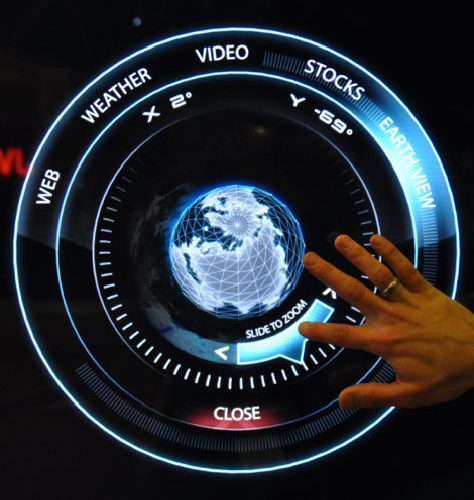Form Follows Function
Touch technology is now the number one focus of developers worldwide, and every new gadget that enters the marketplace sparks huge hype. Motion tracking in 3D space is the current favorite of 2013, first with Kinect, then more recently with Leap Motion. These technologies are extraordinary and open up a wide variety of possibilities for POI and POS systems. But one should choose the interactive technology—for example, touch, multitouch, gesture, or voice—that best fits a particular installation carefully.
For stand-alone POI and POS installations, the best choice of interactive technology is one that visitors can understand most quickly. While the best means of operating a very detailed, multilayered information application is with a highly responsive touchscreen, 3D-motion detection like Kinect’s is appropriate for more playful installations that have less informational value. A good rule of thumb is to look at your content, pick a device, then start programming your user interface. Keep in mind that complex navigation that presents many points of interaction is easier to operate on a touchscreen than via motion-tracking, while Kinect and other motion trackers are perfect for large, swipey gestures.
Figure 1 shows a great example of a presentation that includes both swipe gestures and a detailed touchscreen interface. Pictures That Move created it for the city of Madrid’s Olympic pitch.

Usability is a rallying cry of UX design. Can a person use an application efficiently over long periods of time? With touch and gesture devices for POI and POS, where interactions may be brief, one-time events, an emphasis on usability must be balanced with a focus on rapid learnability and discoverability. Can a user figure out how to perform a specific task without its requiring strong attention, focus, training, ToolTips, or documentation?
Navigation Made Easy
You have only a few seconds to convince users that what your POI or POS installation presents is interesting and worth their time. Only a few seconds during which you need to make both its topic and the touch concept clear. That is why—yet again—less is more. Present users with only a handful of obvious navigation options with clear labels. Nobody has the time or patience to read through a long list of possibilities. If a list is necessary, make sure that it is easily scrollable or implement search functionality.
When it comes to structuring your interactive presentation, don’t make it too complicated. Users should not have to make more than two or three choices before getting to the information they were looking for. Of course, it is always useful to provide a tidbit of information at every level. That way, users more quickly get engaged with your content—although, they might actually take longer to get where they were planning to go.
The agency three monkeys used Ventuz for a touch presentation at the inauguration of KAUST University, shown in Figure 2, which provides a good example of the need for easy navigation. They needed to include a lot of information and did so very cleverly by presenting a bit of information at every step in the navigation. So users could decide whether they already knew enough about a certain topic or needed more—in which case, they could take another step into the content.
 on a Holo Info Terminal
on a Holo Info TerminalWhen designing buttons or sliders, be sure that users can determine what will happen before they click them. You can best accomplish this by using clear language and well-known icons. Don’t fool yourself that what is obvious to you will be obvious to everyone else. Instead, show your icons and labels to people who know nothing about your presentation, then ask them what they would expect to happen if they clicked a button or dragged a slider. (This is standard practice in usability testing, which too often gets bypassed.)
There is a tendency to avoid text in user interface design for multitouch devices—the notion being that it is less elegant. But sometimes labels are necessary for users to feel comfortable with a user interface. For example, as shown in Figure 3, you might need to refer to a slider as Slide to Zoom or a close button might need to read Close. Also, it is essential that you review your content’s information architecture and structure. Make sure that nothing gets lost or remains unseen due to confusing wording or classification.

Design advanced or nuanced features for discoverability. Such discoverable elements should not be critical to getting to essential content, but can instead provide opportunities for delivering the surprise and delight of enhanced functionality. Each discovery of a new feature or tidbit of information in a user interface acts as a reward that helps to reinforce a personal affinity and an increasing intimacy between the user and the application.

